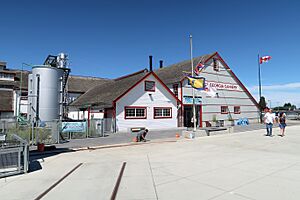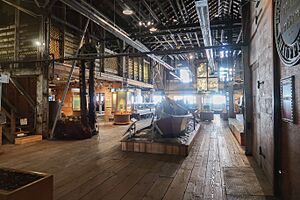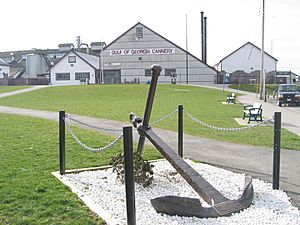Gulf of Georgia Cannery facts for kids
The Gulf of Georgia Cannery is a special place in Steveston, a village in Richmond, British Columbia. It is known as a National Historic Site of Canada. This means it's an important landmark that tells a big part of Canada's story.
The cannery was built way back in 1894. It used to be the biggest producer of canned salmon in British Columbia. Today, it's a fun museum! You can explore interactive exhibits, watch films, and take tours. These activities show how important the cannery was to the history of fishing on Canada's West Coast. A group called the Gulf of Georgia Cannery Society helps run the museum for Parks Canada.
Contents
The Gulf of Georgia Cannery: A Look Back
How the Cannery Began
The cannery first opened its doors in 1894. It was in Steveston, a busy "boomtown" on the Fraser River. A boomtown is a place that grows very quickly. Until 1902, this cannery was the largest in British Columbia. People even called it the "Monster Cannery"! In 1897, it packed over 2.5 million cans of salmon. That's a lot of fish!
Every year, hundreds of people came to work at the cannery. These workers came from many different backgrounds. They included First Nations people, Chinese, Japanese, and European people. Back then, canning fish was one of the biggest jobs in British Columbia. It also produced one of the main things Canada sold to other countries.
New Machines and Changes
Over time, new technology arrived. Machines started doing the work that many people used to do by hand. This meant fewer people were needed for canning salmon. For the Gulf of Georgia Cannery, this led to a smaller role in salmon canning. The very last can of sockeye salmon rolled off the production line in 1930.
After that, two big fishing companies joined together. They formed British Columbia Packers Limited. This company brought together many canneries in the area.
The Cannery During World War II
The Gulf of Georgia Cannery was quiet for a while in the 1930s. But when World War II started in Europe, things changed. The cannery got new money and expanded. It was ready for a new job: canning herring.
New machines and many workers started producing lots of canned herring in tomato sauce. This herring was a major source of food. It helped feed Allied soldiers and people struggling overseas during the war. Canning herring became a huge industry. Also, people started turning herring into oil and meal. This was used to feed animals.
After the War
When the war ended, the demand for canned herring stopped. So, herring canning in British Columbia ended too. By the late 1940s, turning herring into oil and meal became the main activity at the Gulf of Georgia Cannery. The cannery grew bigger three times as this industry boomed.
However, the herring industry faced problems. There was too much overfishing, and the government closed the fisheries in the late 1960s. By the 1970s, a new market appeared in Japan for British Columbia herring roe (fish eggs). This meant the cannery's reduction operation started again. But the new roe industry used much less herring. Catches that used to be hundreds of thousands of tonnes were now only tens of thousands.
The Cannery Closes Its Doors
By 1979, it cost too much to run the cannery's old equipment. So, the reduction plant closed down. The buildings were then used to store fishing nets and boats for a company called Canadian Fishing Company. This was the beginning of the idea to turn the cannery into a museum.
Becoming a National Historic Site
In the 1970s and early 1980s, people in the local community worked hard. They asked different levels of government to save the cannery. In 1979, the Federal government bought the property. Then, in 1984, it was given to Parks Canada.
The building first opened to the public in 1994. This celebrated the cannery's 100th birthday! The Gulf of Georgia Cannery Society was formed in 1986. This local non-profit group works with Parks Canada to develop and run the site. Today, the cannery is one of the few National Historic Sites owned by the government but run by a separate group.
A Timeline of the Cannery
- 1894 – The first L-shaped building was built. It had one line for canning by hand.
- 1897 – The East Wing was added. This gave more space for packing and living areas for seasonal workers. Two more canning lines were added.
- 1906 – A machine for butchering fish arrived. The West Wing was changed to store nets. The East Wing was made shorter because of a new dyke and railway tracks.
- 1932 – A strong windstorm destroyed what was left of the West Wing.
- 1940 – The roof was raised to fit another boiler (a machine that heats water).
- 1943 – An ice house was built. This helped store fish for longer periods.
- 1940–1948 – Many changes and additions were made for the herring reduction process. This included sheds for vitamin oil and drying.
- 1956 – The East Wing of the original building was raised. This was to fit an evaporator. A separator room was built next to it.
- 1964 – A room for grinding and bagging was added near the drying shed.
- 1979 – The Gulf of Georgia reduction plant closed. The building was then used to store fishing nets.
- 1994 – The Gulf of Georgia Cannery National Historic Site of Canada opened to the public.
Visiting the Cannery
You can take tours of the cannery led by special guides. There is also a 25-minute film you can watch if you ask. The museum offers special programs for school groups. The building is easy to get around for people using wheelchairs. Programs are available in both English and French.
Please note that tours were temporarily stopped due to the COVID-19 pandemic.





